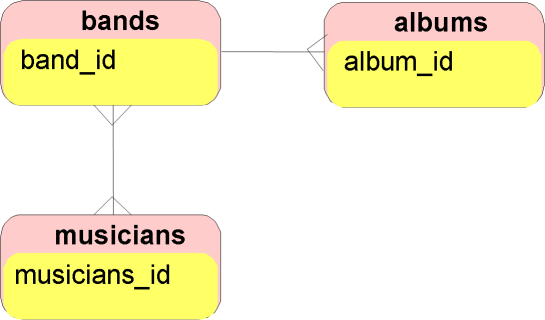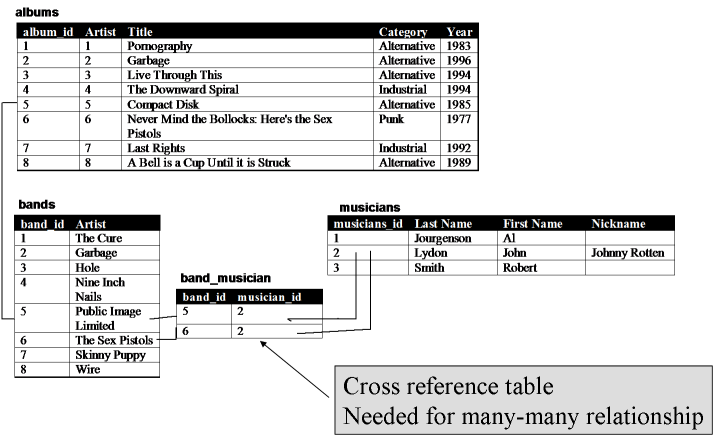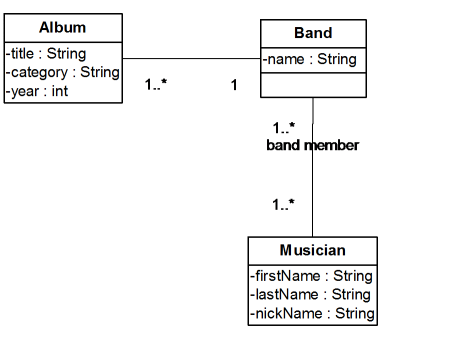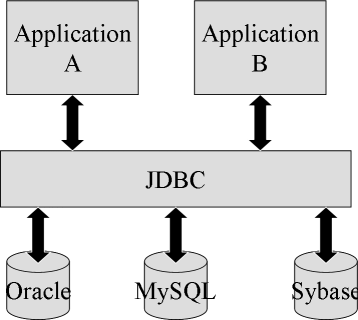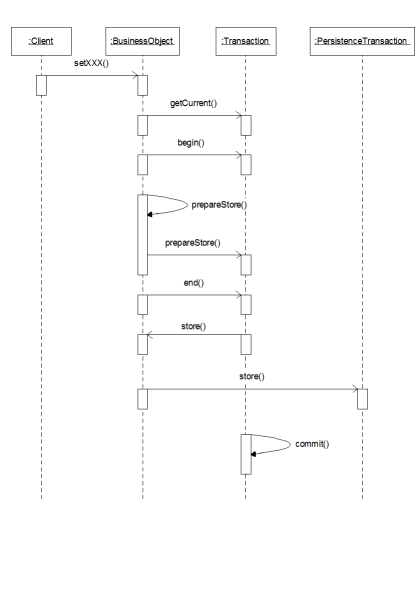Table of Contents
~~SLIDESHOW~~
Enterprise Integration-Tier Services
- The Enterprise Integration Tier is where the Enterprise Knowledge exists.
- There is a prime role of relational databases here.
- Most databases use the Relational Database Model.
- Defined and queried in a dialect of SQL
- Need to map relational tables to objects and back.
- We will introduce SQL and the Java Database Connectivity (JDBC) API and go on to discuss persistence.
- Enterprise Integration is not just about databases so we will conclude with some other examples.
Lecture Contents
What is a Database?
- Programming is data processing
- Data is central to everything that you do with a computer
- A database is a specialized tool for data storage
What is a Relational Database?
Relational databases are most common form of database:
- Consists of a set of tables.
- Each table consists of a set of records (rows of the table).
- Each record consists of a set of attributes (columns of the table).
- Rows of one table can be related to rows of another.
An example: CDs from a Music Collection
| Artist | Title | Category | Year |
|---|---|---|---|
| The Cure | Pornography | Alternative | 1983 |
| Garbage | Garbage | Alternative | 1996 |
| Hole | Live Through This | Alternative | 1994 |
| Nine Inch Nails | The Downward Spiral | Industrial | 1994 |
| Public Image Limited | Compact Disk | Alternative | 1985 |
| The Sex Pistols | Never Mind the Bollocks: Here's the Sex Pistols | Punk | 1977 |
| Skinny Puppy | Last Rights | Industrial | 1992 |
| Wire | A Bell is a Cup Until it is Struck | Alternative | 1989 |
Johnny Rotten Night for a Party
- Easy to select CDs for an Alternative or a Punk night.
- What if we want a Johnny Rotten night?
- No data for that in the table.
- Need another table of musicians.
| Last name | First name | Nickname |
|---|---|---|
| Jourgenson | Al | |
| Lydon | John | Johnny Rotten |
| Smith | Robert |
Keys (1)
In order to relate musicians to bands and bands to CDs we need a unique key to the data.
| album_id | Artist | Title | Category | Year |
|---|---|---|---|---|
| 1 | The Cure | Pornography | Alternative | 1983 |
| 2 | Garbage | Garbage | Alternative | 1996 |
| 3 | Hole | Live Through This | Alternative | 1994 |
| 4 | Nine Inch Nails | The Downward Spiral | Industrial | 1994 |
| 5 | Public Image Limited | Compact Disk | Alternative | 1985 |
| 6 | The Sex Pistols | Never Mind the Bollocks: Here's the Sex Pistols | Punk | 1977 |
| 7 | Skinny Puppy | Last Rights | Industrial | 1992 |
| 8 | Wire | A Bell is a Cup Until it is Struck | Alternative | 1989 |
Keys (2)
In order to relate musicians to bands and bands to CDs we need a unique key to the data.
| artist_id | Last name | First name | Nickname |
|---|---|---|---|
| 1 | Jourgenson | Al | |
| 2 | Lydon | John | Johnny Rotten |
| 3 | Smith | Robert |
Logical Data Model for Sample Database
Interpretation of the logical data model:
- each band has one or more albums;
- each album belongs to exactly one band;
- each band contains one or more musicians;
- each musician is a member of one or more bands.
Physical Data Model
UML to Physical Data
Classes, objects, properties and methods:
- Class maps to table
- Each object will be a row in the table
- Each property will be a column in the table
- Only properties are stored, no place in the database for methods.
Associations:
- One to many associations: index to one side is stored in a column in the many table as a foreign key.
- Many to many associations: need a cross reference table containing indices to both linked tables as foreign keys.
Object model: unique id implied.
Relational model: unique id must be explicit.
An Introduction to SQL
- All major databases support the Structured Query Language (SQL).
- SQL is not a programming language as such.
- An example of SQL is
SELECT title FROM albums
SQL commands
There are essentially only five SQL commands:
CREATE– defines a new tableINSERT– inserts a record into a tableUPDATE– updates an existing recordDELETE– deletes a record from a tableSELECT– finds records in database * All major databases support the Structured Query Language (SQL).
CREATE
- Before you can put data into a database you need to create the tables:
CREATE TABLE TABLE_NAME ( column_name column_type column_modifiers, ..., column_name column_type column_modifiers)
CREATE Musicians
- Unfortunately, this is database specific. In MS Access (where it is called a data definition query) this works:
CREATE TABLE musicians ( musician_id INT PRIMARY KEY, last_name CHAR(40), first_name CHAR(40), nickname CHAR(40))
CREATE (2)
- The database-dependent part of the
CREATEstatement lies in the column modifiers. - These might be modifiers such as
NOT NULL,PRIMARY KEY, or other modifiers that say something about the column and the kind of data it can take. - You have to read the manual.
INSERT
- Used to add data to tables. Called an append query in Access.
INSERT INTO TABLE_NAME (column_name, ..., column_name) VALUES (VALUE, ..., VALUE)
- First value matches to first named column, 2nd to 2nd etc (types have to match column types in the table)
INSERT INTO musicians (musician_id, last_name, first_name, nickname) VALUES (2, 'Lydon', 'John', 'Johnny Rotten')
- Has to be repeated for every data record!
UPDATE
- Used to add modify the data in a table. Called an update query in Access.
UPDATE TABLE_NAME SET column_name = VALUE, ..., column_name = VALUE WHERE column_name = VALUE
UPDATE Examples
- E.g. to change date in The Downward Spiral
UPDATE albums SET YEAR = 1994 WHERE album_id = 4
* Can be used to update several records at once:
UPDATE albums SET category = 'old music' WHERE YEAR < 1980
DELETE
- A lot like the update query. Used to delete rows that match a where clause. Called a delete query in Access.
DELETE FROM TABLE_NAME WHERE column_name = VALUE
- E.g. to delete The Downward Spiral from your collection
DELETE FROM albums WHERE album_id = 4
SELECT
- Most common type of query.
SELECT column_name, ..., column_name FROM TABLE_NAME WHERE column_name = VALUE
- E.g to select all of the industrial albums.
SELECT title FROM albums WHERE category='industrial'
Query By Example
- In user friendly tools like Access it is possible to create queries and relationships without having to actually write any SQL.
- Called “query by example”.
- A good way to create your queries for use in Groovy or Java!
Joins and …
- When you want to follow relationships such as “find all albums on which Johnny Rotten played” you need to follow the relationships between tables using joins.
- A join creates a virtual table on the fly that contains data from two or more tables. E.g.
SELECT bands.band_name FROM bands.albums WHERE albums.category='alternative' AND bands.band_id = albums.artist
- But we still need to relate album to artist for which there is no direct link. For this we need a sub query.
… Sub-queries
- To relate album to artist for which there is no direct link we need a sub query.
- In this case we need to select all the bands for which Johnny Rotten was a musician…
- … and then get the album titles for those bands.
SELECT title FROM albums WHERE artist IN ( SELECT bands.band_id FROM bands, band_musicians WHERE band_musicians.musician_id = 2 AND bands.band_id = band_musicians.band_id )
Lecture Contents
The Trouble with Databases
- One of the major problems with databases has been the feature wars between the database companies.
- There is a “standard” database language, Structured Query Language (SQL-92), but you must usually know which database vendor you're working with despite the standard.
- JDBC is designed to be platform-independent, so you don't need to worry about the database you're using while you're programming.
- However, it's still possible to make vendor-specific calls from JDBC so you aren't restricted from doing what you must.
A Word about SQL and Portability
- One place where programmers may need to use SQL type names is in the SQL
TABLE CREATEstatement when they are creating a new database table and defining the SQL type for each column. - Significant variations between SQL types supported by different database products.
- E.g. large binary values:
- Oracle:
LONG RAW, - Sybase:
IMAGE - Informix:
BYTE - DB2:
LONG VARCHAR FOR BIT DATA.
- Therefore, if database portability is a goal you should try to use only generic SQL type identifiers.
Design for Portability
- Reliance on a third party product can break the platform-independence of Java.
- You should try to limit the impact of such things by choice of suitable abstractions.
- E.g.
- Isolate database-specific code in order to centralize any changes that you may need to perform to port to a new environment.
- Consider use of configuration files to specify database driver, table definition, query and update commands, etc that may vary.
- Use abstractions [see later]:
- map object attributes to database row
- map query result to collection
- Note when an object changes … it will need to be updated in the database.
What is JDBC?
A single API for database access:
- JDBC is an SQL–level API.
- JDBC capitalizes on the experience of existing database APIs.
- JDBC is designed for simplicity.
SQL-level API
- You construct SQL statements and embed them (as strings) inside Java API calls.
- You are using SQL.
- JDBC smoothly translates between world of the database and the world of the Java application.
- Results from the database are returned as Java objects.
- Access problems are thrown as exceptions.
- You can even completely hide the database from your application objects (as we shall see)
Based on existing APIs
- The need to provide a universal access API is not new.
- Open Database Connectivity (ODBC) a standard API for databases on the windows platform provided some inspiration.
- One of the first drivers developed was the JDBC-ODBC bridge which makes it easy to take to a database under windows.
- Other inspiration comes from such APIs as the X/OPEN SQL Call Level Interface (CLI).
- By basing JDBC on such industry standards improved the chance of take up by the industry.
Designed for Simplicity
- Simple and common tasks use simple interfaces.
- The method calls you make correspond to the logical operations you'd think of doing when gathering data from a database:
- connect to the database
- create a statement
- execute the query
- look at the result set.
- JDBC provides several other interfaces for handling more complex and unusual tasks.
The Structure of JDBC
- Each Java interface is implemented differently by a database vendor.
- The set of classes that implement the interface is called a driver.
- You only need to use the interface which is the same for all databases.
Basic Classes and Interfaces of the JDBC API
Databases and Drivers
- Type 1 – bridging technology. Access database through another database interface. E.g. JDBC-ODBC. Requires software to be installed on client machine.
- Type 2 – native API drivers. Driver calls C or C++ methods provided by vendor. Requires software to be installed on client machine.
- Type 3 – generic network API that accesses database on a server machine via a middleware application that translates client requests into database API on the server. No software needed on client.
- Type 4 – direct connection to network protocols built into database using Java sockets. Usually only available from the database vendor.
JDBC Driver Managers
- To allow for platform independence, JDBC provides a driver manager that dynamically maintains all the driver objects that your database queries will need.
- If you have three different kinds of vendor databases to connect to, you'll need three different driver objects.
- The driver objects register themselves with the driver manager at the time of loading, and you can force the loading using
Class.forName().
Database URL
- To open a database, you must create a “database URL” that specifies:
- That you're using JDBC with “
jdbc”. - The “subprotocol”: the name of the driver or the name of a database connectivity mechanism.
- The database identifier. This generally provides a logical name that is mapped by the database administration software to a physical directory where the database tables are located.
- All this information is combined into one string, the “database URL.”
- Examples:
String dbUrl = "jdbc:odbc:CDs"; jdbc:rmi://192.168.170.27:1099/jdbc:cloudscape:db
Making a Connection
- To connect to the database, call the static method
DriverManager.getConnection( )and pass it the database URL, the user name, and a password to get into the database. - You get back a
Connectionobject that you can then use to query and manipulate the database. - The following example opens a database of CD data and looks for a CD's that match a given theme as given on the command line.
- It selects only the CDs that match the category then prints out the CD data:
Find CDs for a party
See notes for listing.
- 1|Example 1: Database lookup (at-m42/Examples/lecture14/Lookup.java)
extern> http://www.cpjobling.org.uk/~eechris/at-m42/Examples/lecture14/Lookup.java
… define db attributes
static final String DB = "jdbc:derby:CDs"; static final String USER = ""; static final String PASSWORD = ""; static final String DRIVER = "org.apache.derby.jdbc.EmbeddedDriver";
- These values used to make the connection: dbURL: protocol “
jdbc”; subprotocol “derby”; database id: “CDs” - user and password are used for access control if database management system needs them.
… load the driver
Class.forName(DRIVER);
- This could throw
ClassNotFoundExceptionwhich we don't bother the catch! - That's why it has to be declared as an exception that may be thrown by
main().
… connect to database
Connection c = DriverManager.getConnection(DB, USER, PASSSWORD);
- The atabase driver knows how to connect to databases that it manages.
- Connection object represents the database for rest of session.
- Possible (and desirable) to pool connections if many clients may access same database simultaneously.
- Database management system is responsible for handling simultaneous updates.
… create a "statement" object
Statement s = c.createStatement();
Statementrepresents and atomic interaction with the database.- Can be used to query database, create tables, update records or delete records.
- SQL code is passed to statement object (as a
String). Statementobject returns aResultSet.- For efficiency, statements can be “compiled” by DBMS so that they run faster.
… execute query and return results
// SQL query String QUERY = "SELECT albums.title, bands.band_name, albums.year\n" + " FROM bands INNER JOIN albums ON \n" + " bands.band_id = albums.artist \n" + " WHERE (((albums.category)='" + args[0] + "'))" // SQL code: ResultSet r = s.executeQuery(QUERY);
executeQuery()takes aStringparameter- String is SQL code in this case
- Returns a
ResultSet(an'Iterator) - Query term
albums.categoryis taken from arguments to program. Resultis fields: albums.title, bands.band_name, albums.year; for records in join of albums and bands whose albums.catogory field matchesargs[0].- Easiest way to create a query is to use query by example with a database tool.
… process results
while (r.next()) { // Capitalization doesn't matter: System.out.println("Have a result!"); System.out.println(r.getString("Title") + " by " + r.getString("bAND_NAME") + " released in " + r.getString("YEAR") + "."); }
ris anIterator.r.next()moves “cursor” to next result.- Returns false if there is no next (query returned nothing) or have reached last record.
- You must call
next()before first result is used. getXxxx(String columnName)gets item of typeXxxxfor column named byString. Most standard Java types (includingObject) can be returned.updateXxxx(String columnName, Xxxx value)can be used to update a record value.
… close down connection and clean up
s.close();
- Closing the statement also closes the results set.
- We do not need to close the database connection explicitly as it's closed when the program exits.
- If you have a pool of connections you'd want to release your connection (returning it to the pool) when you've finished.
Simplified Queries with Groovy
- 1|Example 2; Database lookup in Groovy (at-m42/Lectures/lecture14/Lookup.groovy)
extern> http://www.cpjobling.org.uk/~eechris/at-m42/Examples/lecture14/Lookup.groovy
As with other examples we've seen in this course, the designers of Groovy have created a JDBC API that further simplifies the interaction with a JDBC-supported database (and as we'll see, takes this even further in the Grails framework).
In this example we note immediately that the opening of a connection to a database is achieved in a single factory method def sql = Sql.newInstance(DB, USER, PASSWORD, DRIVER). Once we have the Sql object, we can use the eachRow method, which takes a closure, to process each row. Note also, that the results are returned as a Map, so we can refer to each field as r.band_name (or if you prefer r['band_name'] rather than the more long-winded r.getString("bAND_NAME")). Also, because Groovy is a dynamic language, we need not know, nor care, what the type of the field represents.
Further more, the use of multi-line strings simplifies the creation of queries, and because String interpretation works, queries can easily be made programmatic.
SQL Data-types and Java Data-types
- Should always use Java data-types and map these to database rather than the other way around.
| Java Type | SQL Types (from java.sql.Types) |
|---|---|
boolean | BIT |
byte | TINYINT |
short | SMALLINT |
int | INTEGER |
long | BIGINT |
float | REAL |
double | DOUBLE |
java.Math.BigDecimal | NUMERIC |
java.lang.String | VARCHAR or LONGVARCHAR |
SQL Data-types and Java Data-types (2)
| Java Type | SQL Types (from java.sql.Types) |
|---|---|
byte[] | VARBINARY or LONGVARBINARY |
java.sql.Date | DATE |
java.sql.Time | TIME |
java.sql.Timestamp | TIMESTAMP |
java.sql.Blob | BLOB (SQL3 datatype) |
java.sql.Clob | CLOB (SQL3 datatype) |
java.sql.Array | ARRAY (SQL3 datatype) |
java.sql.Ref | REF (SQL3 datatype) |
java.sql.Struct | STRUCT (SQL3 datatype) |
What else does JDBC provide?
- Can call JDBC from a servlet or from an applet.
- It is possible to create a database and populate it from Java. Also possible to delete tables from a database.
- Select, update, delete queries supported.
DatabaseMetaDatainterface is huge! It is provided to allow you to query the capabilities of a database from Java and work around database idiosyncrasies.- Many more features provided for enterprise applications. Support for database transactions, rollback, etc.
Transaction Logic (1)
- Often you need to issue many updates or inserts together as part of a single transaction
- New band: add all musicians in the band at the same time.
- Individual SQL statements may fail, e.g. because of a network problem.
- If we have a failure in the middle of a group of transactions you can be left with corrupt data.
- SQL allows you to group a set of commands that should be executed together into a transaction.
Transaction Logic (2)
- As transaction is one or more SQL statements that should be treated as a single unit of work.
- If one statement in the transaction fails, the whole transaction should be aborted, including any statements that have been successfully executed.
- If all the statements are successfully executed the changes can be made permanent.
- An abort is called a
ROLLBACK– database is left in the state it was in before transaction began. - A transaction is made permanent with a
COMMIT. - If not committed the database is not changed by a transaction!
Lecture Contents
Immortal Objects
- How to ensure that the state of your business objects survives (
persists) beyond the ending of one process to the start of the next. E.g. to survive crashes and shutdown. - Although you can use files for persistence, it doesn't scale well.
- These days you have to use a relational database. If you use Java to implement your application you have to use JDBC.
- How can persistence issues can be affectively hidden from the business objects that rely on it?
Persistence is Last Step in a Transaction
- In distributed applications we need transactions to guarantee data integrity.
- Commit if successful. Rollback if fails.
- Transaction choreographs a persistence operation.
- When the transaction is notified that it is complete it creates a persistence transaction which tells each object modified in the transaction to insert, update or delete itself in the persistent store.
- The persistence transaction makes sure that all data store accesses take place within a single data store transaction (i.e using the same connection object) and is committed at the end.
- The component model doesn't care about how the persistence is achieved. It only cares about the transaction.
Component Transaction and Persistence Transaction
Lecture Contents
Persistence Patterns: Transaction script
In many applications it is natural to work directly with the relational model, issuing SQL queries and parsing result sets.
- This is known as the Transaction Script pattern1): business logic is organized into procedures for each use case.
- Direct use of SQL is also well suited for aggregating queries and set-based updates (accessing large amounts of data or updating many tables in the same transaction)
Persistence Patterns: ORM
Another scenario is that you have simple queries returning small sets of rows (often in a single table), which receive selective updates.
- Little need for set-based updates
- Data entities mapped to persistent Java objects
- Business logic deals with these objects rather than the tables and records.
General term for this pattern is Object-Relational Mapping (ORM)
Patterns for ORM Strategies
- Active record – wraps a row in a database table, encapsulates the database access, and adds domain logic to the data.
- Data mapper – A layer of mappers that move data between objects and a database while keeping them independent of each other and the mapper itself.
- Query object – An object that represents a database query
- Unit of work – Maintains a list of objects effected by a business transaction and coordinates the writing of changes and the resolution of concurrency problems.
Persistence Frameworks
- You can “roll your own” persistence framework …
- … but it's a non-trivial task and fraught with difficulties and traps.
- Better to use an existing framework. Many available!
- All implement Data Mapper, Query Object and Unit of Work patterns to provide Transparent Persistence for Java objects.
Reese (see Recommended Reading) gives an extended example of the development of a persistence framework.
The most widely used persistence frameworks are:
- Java EE Container Managed Persistence (CMP) (more later),
- Java Data objects (JDO) (Java extension),
- Hibernate (a widely deployed open source framework) and
- The “official” Java Persistence API (JPA) part of Java EE 5 and available as a standalone extension API for Java SE 6.
The Object/Relational Impedance Mismatch
- For all but the simplest domain models, there is no direct match from relational database to object model.
- OO concepts such as class, polymorphism, and inheritance have no direct analogy in an RDMS.
- RDMS concepts such as normalized data, sets and efficient access have no direct relationship in the OO world.
- It's best to keep the two worlds separate and in the domain of the experts.
- Use an ORM framework (if it's appropriate) to provide the bridge between the two worlds.
Some Issues that the Developers of an ORM Have to be Aware Of
- Identity: ensuring a record in a database is unique in a global sense.
- Instantiated objects should be cached: avoids a further trip to the database if it is needed in two separate transactions.
- “Dirty” objects (objects that have been created or changed in a transaction) have to be committed to the database in a single atomic operation.
- Objects that have not been changed do not need to be written back to the database.
- Queries may result in large numbers of records being returned from a database:
- Usually returned as a collection
- However objects in the collection should not be instantiated unless it is needed.
Choosing a Persistence Strategy (1)
- Many enterprise applications need to use legacy databases, or share the database with other systems, so choices are limited!
- Despite the hype, it is rare for an enterprise to change its database supplier, so it is often not worth completely abstracting the details of a DBMS out of code.
- It is worth providing a data access layer so that your business logic does not talk directly JDBC but goes through a set of Data Access Objects.
- If the database schema changes, it will be in the access layer that changes will be needed, not in the business logic.
- If the business logic changes, again, persistence code changes are limited to the access layer.
Choosing a Persistence Strategy (2)
- In some applications with a limited number of simple tables it will be quickest to use active record and talk directly to the database.
- If the application will require heavy use of set access, aggregation of data from many tables, or batch updates in many rows, a direct implementation using transaction script may be most efficient.
- ORM is a complex strategy which be of benefit only for complex domain models and or databases
Choosing a Persistence Strategy (3)
ORM can be of benefit if:
- Your application has the typical CRUD – create, retrieve, update, delete – workflow for domain objects.
- Objects are found in large sets but are updated and deleted individually.
- A large number of objects exist but they are “read-mostly”
- There is a natural mapping between classes and fields and database tables and records
- There are no unusual requirements such as the need to use customized SQL optimizations.
- For Java programmers ORM has the advantage of keeping SQL out of the code. But that is why we have DB architects!
Lecture Contents
Other Forms of Enterprise Integration
- Enterprise integration is not just about databases and SQL.
- Enterprise information systms also often have to be built in to enterprise applications.
- Main technologies for this form of integration is the Java Connectivity API and Web Services.
- May not be talking Java so CORBA and similar technologies may come into play.
—-
Some examples of enterprise information systems are:
- Human Resources Systems
- Payroll systems
- Enterprise Resource Planning
- Business to Business Systems
- Enterprise communication systems
- Other so-called “legacy” systems
